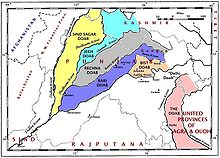| Revision as of 20:02, 24 April 2024 view sourceSumanuil (talk | contribs)Extended confirmed users82,441 edits Restored revision 1220312277 by Yamaguchi先生 (talk)Tags: Twinkle Undo← Previous edit | Revision as of 20:07, 24 April 2024 view source Daniel Quinlan (talk | contribs)Edit filter managers, Administrators17,739 editsm Protected "Sial (tribe)": Contentious topics enforcement for WP:CT/IPA; requested at WP:RfPP ( (indefinite) (indefinite))Tag: TwinkleNext edit → |
| (No difference) | |
Revision as of 20:07, 24 April 2024
Tribe of Punjab
| Sial Tribe | |
|---|---|
| سیال جنجاتی | |
| Religions | |
| Languages | Punjabi |
| Country | India, Pakistan |
| Region | Punjab |
| Ethnicity | Punjabi |
The Sial or Siyal (Punjabi and Urdu: سيال) is a Punjabi Rajput clan found in the Punjab region of the Indian subcontinent, split between India and Pakistan.
Ethnographic classification
Further information: MahnikeDenzil Ibbetson, an administrator of the British Raj, classified the Sial as Rajput tribe.
Following the introduction of the Punjab Land Alienation Act in 1900, the authorities of the Raj classified the Sials who inhabited the Punjab as an "agricultural tribe", a term that was administratively synonymous with the "martial race" classification that was used for the purposes of determining the suitability of a person as a recruit to the British Indian Army.
History

During the fifteenth- and sixteenth-century periods of the Mughal empire, the Sial and Kharal tribes were dominant in parts of the lower Bari and Rachna doabs of Punjab. In the 18th century, Sial chief Walidad Khan gained control of Rechna Doab including cities of Chiniot, Pindi Bhattian, Jhang and Mankera. Next chief, Inayatullah Khan (1747–1787) was a successful General who won 22 battles against Bhangi misl and the Multan chiefs. In 1803, the Sial chief Ahmed Khan was forced to pay tribute to Ranjit Singh who ultimately conquered the Sial capital of Jhang in 1806. However, Ahmed Khan seized control of Jhang again in 1808 with the help of Pathans of Multan. The 1809 Treaty of Amritsar, agreed between Ranjit Singh, the Sikh leader, and the British, gave him a carte blanche to consolidate territorial gains north of the Sutlej river at the expense both of other Sikh chiefs and their peers among the other dominant communities. In 1816, Ahmed Khan was finally ousted, having previously been forced to pay tribute to Singh for several years. The Sials in Jhang, as in many other areas of the Punjab, had once been nomadic pastoralists. They did not necessarily cultivate all of the land that they controlled and it was the actions of the Sikh empire and, later, the land reforms of the Raj administration that caused them to turn to cultivation.
Popular culture
The Heer Ranjha and Mirza Sahiban, epic poems of Punjabi literature are pieces of fictional writing which refer to the Sials, who were the dominant tribe at the time. The two heroines, Heer is depicted as young and independent-minded daughter of a Sial chieftain in revolt against traditional tribal conservatism. Heer is portrayed as a Sial Rajput and Sahiban is also from a Sial Rajput family.
Notable people with this surname
- Muhammad Arif Khan Rajbana Sial, former federal and provincial minister
- Najaf Abbas Sial, Member, Provincial Assembly of Punjab (2002 - 2007) from Jhang District
- Ghazalla Sial, member, Provincial Assembly of Sindh (2018 - 2023) and (2013 - 2018) from Khairpur.
Ubaid Ullah Khan Sial Commissioner jhang
References
- Peacock, A. C. S., ed. (2017). Islamisation: comparative perspectives from history. Edinburgh: Edinburgh University Press. ISBN 978-1-4744-1712-9. OCLC 959035754.
The Siyal clan of Jats of Jhang District, according to both the shrine's hagiographic accounts and the earliest known history of the clan itself, was introduced to Islam by Baba Farid himself, who is said to have converted the clan's founder, Ray Siyal
- Bayly, Susan (2001). Caste, Society and Politics in India from the Eighteenth Century to the Modern Age. Cambridge University Press. p. 140. ISBN 978-0-521-79842-6.
- Mazumder, Rajit K. (2003). The Indian Army and the Making of Punjab. Orient Blackswan. pp. 104–105. ISBN 978-81-7824-059-6.
- ^ Griffin, Lepel Henry; Massy, Charles Francis (11 August 2015). The Panjab Chiefs: Historical and Biographical Notices of the Principal Families in the Lahore and Rawalpindi Divisions of the Panjab, Volume 2. Creative Media Partners, LLC. p. 505. ISBN 978-1-297-73366-6.
- Grewal, J. S. (1998). The Sikhs of the Punjab. Cambridge University Press. pp. 4, 102–10 248. ISBN 978-0-521-63764-0.
- van den Dungen, P. H. M. (1968). "Changes in Status and Occupation in Nineteenth Century Panjab". In Low, Donald Anthony (ed.). Soundings in Modern South Asian History. University of California Press. pp. 72–74.
- Mirza, Shafqat Tanvir (1991). Resistance Themes in Punjabi Literature. Lahore: Vanguard Books. pp. 9–17.
- Shackle, Christopher (1992). "Transition and Transformation in Varis Shah's Hir". In Shackle, Christopher; Snell, Rupert (eds.). The Indian Narrative: Perspectives and Patterns. Otto Harrassowitz Verlag. p. 243. ISBN 978-3-447-03241-4.
The Hir-Ranjha story is rather more complex in that even in its most reduced forms it implies a double rather than a single sequence of transitions associated with transformations of the hero. Dhido, a Rajput of Takht Hazara in north-western Panjab, known by his caste-name as Ranjha, leaves home on the death of his father, and travels to Jhang, where he and Hir, daughter of the Rajput chieftain of the Sial clan, fall in love. Their affair can only be sustained by Ranjha shedding his own chieftainly status to become Hir's father's buffalo-herd (mahinväl), thus enabling them to meet secretly in the grazing-grounds by the river Chenab.
- Khan, Hussain A (2004). Re-Thinking Punjab: The Construction of Siraiki Identity. Lahore : Research and Publication Centres. p. 131. ISBN 978-969-8623-09-8.
- Front seat: Heer Ranjha retold Dawn (newspaper), Published 16 September 2012, Retrieved 3 June 2023
- "Najaf Abbas Sial - Member Profile". Provincial Assembly of the Punjab website. Archived from the original on 12 April 2016. Retrieved 3 June 2023.